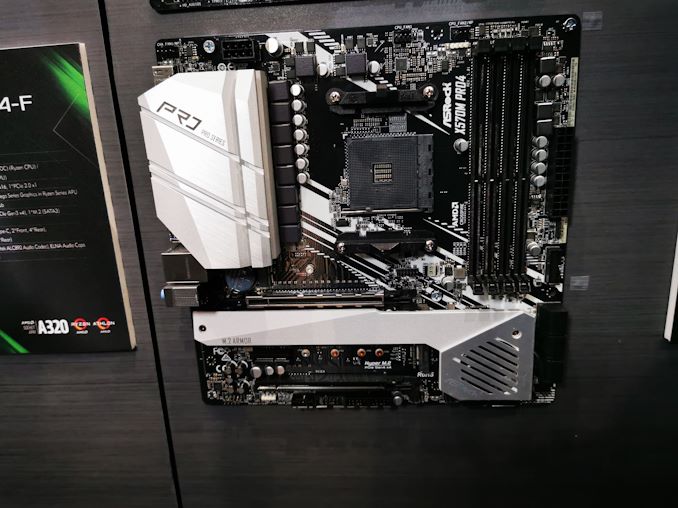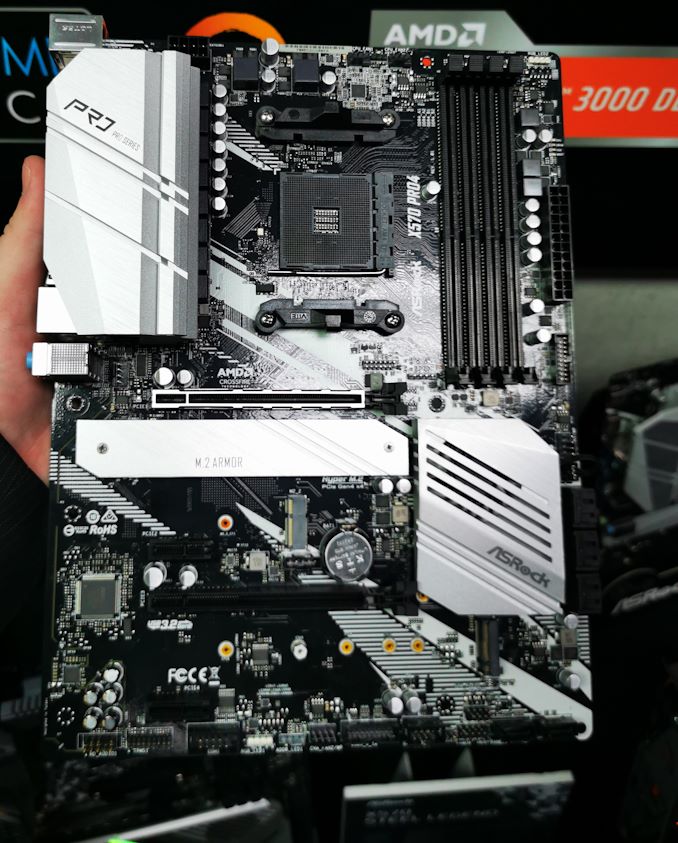The AMD X570 Motherboard Overview: Over 35+ Motherboards Analyzed
by Gavin Bonshor on July 9, 2019 8:00 AM ESTASRock X570 Pro4 & X570M Pro4
ASRock unveiled a number of its X570 models during Computex 2019: a lot of gaming-focused models, and some extremely high-end offerings, but the ATX sized ASRock X570 Pro4 and microATX X570M Pro4 looks set to offer users less bling and more functionality at a lower price point.
Starting with the design of the ASRock X570 Pro4 and X570M Pro4 models, both models use the same silver and black theme throughout, with shining silver heatsinks, and a solid looking aluminium rear panel cover which doubles up as the power delivery heatsink. Both the ATX and microATX models use the same 10-phase power delivery, with both opting to use a single 8-pin 12 V EPS CPU power input. Both have dual PCIe 4.0 M.2 slots with one M.2 heatsink, with eight SATA ports, and both also use an Intel Gigabit LAN port, and a Realtek ALC1220 HD audio codec.
The primary difference aside from the form factor is the ASRock X570 Pro4 naturally has more PCB space for extra PCIe connectivity. This includes two PCIe 4.0 x1 slots on the X570 Pro4 compared to the single PCIe 4.0 x1 on the X570M Pro4, but surprisingly, both feature two full-length PCIe 4.0 x4 slots and an M.2 Key E for users to add their own Wi-Fi/BT module. Both include a DisplayPort and HDMI video output on the rear panel, and four memory slots capable of supporting up to DDR4-4066 with a maximum capacity of up to 64 GB.

ASRock X570M Pro4 microATX motherboard at Computex 2019
The rear panel on both the ASRock X570 Pro4 and X570M Pro4 are identical in terms of connections and includes a single USB 3.1 G2 Type-A, a single USB 3.1 G2 Type-C, six USB 3.1 G1 Type-A ports, and a single Ethernet port powered by an Intel I211AT Gigabit controller. For audio, there are three color coded 3.5 mm audio jacks which is controlled by a Realtek ALC1200 HD audio codec.
It's clear that the X570 Pro4 and X570M Pro4 models are aimed at users with more a more professional focus; this is prevalent in the feature set and the aesthetic. There is nothing flashy about the Pro4, but it does represent a more modest offering in its X570 product stack with the X570 Pro4 priced at $170, with the X570M Pro4 coming in at a slightly higher MSRP of $186












225 Comments
View All Comments
DigitalFreak - Tuesday, July 9, 2019 - link
I think the only advantage of using a 2000 series CPU with an X570 board will be PCIe 3.0/4.0 support. The X370/X470 only supported PCIe 2.0. In theory, the connection from the 2000 processor to the X570 chipset should run at PCIe 3.0 speeds.FreckledTrout - Tuesday, July 9, 2019 - link
The x370 chipset and x470 both supported PCIe 3.0 with either a 1xxx or 2xxx Ryzen CPU. If you are not running a 3xxx CPU in the x570 board there isn't any major feature that should cause one to want to upgrade.DigitalFreak - Tuesday, July 9, 2019 - link
@FreckledTrout - Yes and no. The interconnect between the CPU and the chipset is PCIe 3.0 on X370 / X470, but all the PCIe lanes that come off the chipset are 2.0. Running a 2000 series CPU in an X570 board would give you a PCIe 3.0 link between the CPU and the chipset, with either PCIe 3.0 or 4.0 lanes coming off the chipset (depends on if AMD drops everything to PCIe 3.0 with a 2000 series processor).extide - Tuesday, July 9, 2019 - link
It looks like they still allow the chipset lanes to be 4.0. So you'd have 3.0 link to cpu, but 4.0 from chipset to devices.Targon - Thursday, July 11, 2019 - link
Since you have at least one or two PCI Express slots that are connected to the CPU, not chipset, that almost becomes a non-issue. On my Asus ROG Crosshair VI Hero(X370), you have PCI Express 3.0 x16 for the first slot, or x8/x8. The third PCI Express x16 slot is a 2.0 I believe, which is still enough to get the job done for many devices. Even with the X570 board with a first or second generation Ryzen processor, the most you end up with is an extra 3.0 supporting slot. Note that many boards may have x16 slots, but they are x8 electrically, so you won't see the full bandwidth anyway in those slots.sorten - Tuesday, July 9, 2019 - link
Thanks Gavin! This is a great resource and is exactly what I needed to help build my new system.willis936 - Tuesday, July 9, 2019 - link
The return of the 40mm fan! Those are the most obnoxious components ever. No one has missed them in the past ten years.Kastriot - Tuesday, July 9, 2019 - link
Buy Asrock aqua and problem solved.FreckledTrout - Tuesday, July 9, 2019 - link
I'm waiting for the next iteration of board for this reason. I'm speculating the next round the chipset will be on 7nm.abufrejoval - Tuesday, July 9, 2019 - link
The genious about that chiplet design is that the chipset doesn't actually benefit nearly as much from the shrink, as pure logic or SLC caches: The monolithic guys pay the 7nm overhead (e.g. EUV) for I/O while the geometry of the transistors in the I/O area is mostly determined by the need to power long motherbord or even slot traces.So while waiting is never a bad idea when your need clearly isn't overwhelming you, waiting for that shrink could turn out rather long. These days I/O heave chips might never be done in smaller geometries, because of that and because packaging has matured.